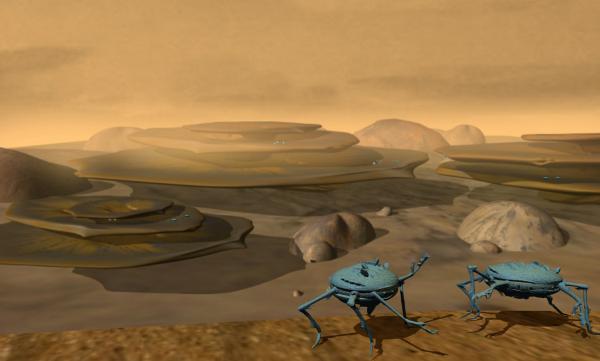BY LETTER
Muuh Architecture
 Image from Steve Bowers |
The alien xenosophonts known as the Muuh inhabit cold, Titan-like worlds; their architecture is based on living coral-like detritus-feeding organisms.
In a Muuh-style ecosystem, organic polymers and other compounds such as acetylene are formed in the energetic upper atmosphere and rain down onto the surface, where wind speeds are lower. Large colonial organisms that often resemble tabular corals collect these organics and use them in their metabolism; these colonies attempt to overgrow each other with their flat to funnel-shaped collection structures. Beneath them and between them it is even darker than it is on the surface of Solsys' Titan, especially in the most favoured sites where the reef-forest may be many layers deep. This is the primary environment that the Muuh probably evolved to live in, if in fact they are actually evolved beings. In this dark environment the primeval Muuh would have used their primary senses of echolocation and infrared, as well as their excellent sense of touch and smell to hunt creatures that graze on the coral-like colonial organisms.
In the modern era, the Muuh have modified both the coralline organisms that make up the structure of the reef-forest and the associated ecosystem of animals and saprophytes to suit their own purposes. The primary structures have been shaped to become comfortable dwelling places that provide not only shelter and food but other services such as communication or information storage and processing. The animals that live on and in them and graze on them are likewise herded and constrained by Muuh domestication and biotech modification and serve a variety of purposes.
At first glance a Muuh city and a wilderness reef-forest can be difficult to distinguish other than by the density of the Muuh population. After so many millions of years of interaction between natural evolution and Muuh biotechnology it is equally true to say that a Muuh city is a cultivated reef-forest as to say that the 'wild' or 'natural' reef-forests are abandoned or feral cityscapes.
Related Articles
- Muuh Iceship
- Muuh Pylons
- Muuhformer Minds
- Muuhian Epoch - Text by M. Alan Kazlev
Local (Perseus-Outer Orion) historical epoch characterized by the Muuhian interstellar civilization; 1.2 to 0.6 mya. Approximately equivalent in time to the middle Pleistocene of Old Earth. The Muuhian Epoch was followed (after a long period of time) by the Auldlimnerian Epoch. - Muuhome
Appears in Topics
Development Notes
Text by Steve Bowers and Stephen Inniss
Initially published on 16 October 2014.
Initially published on 16 October 2014.






